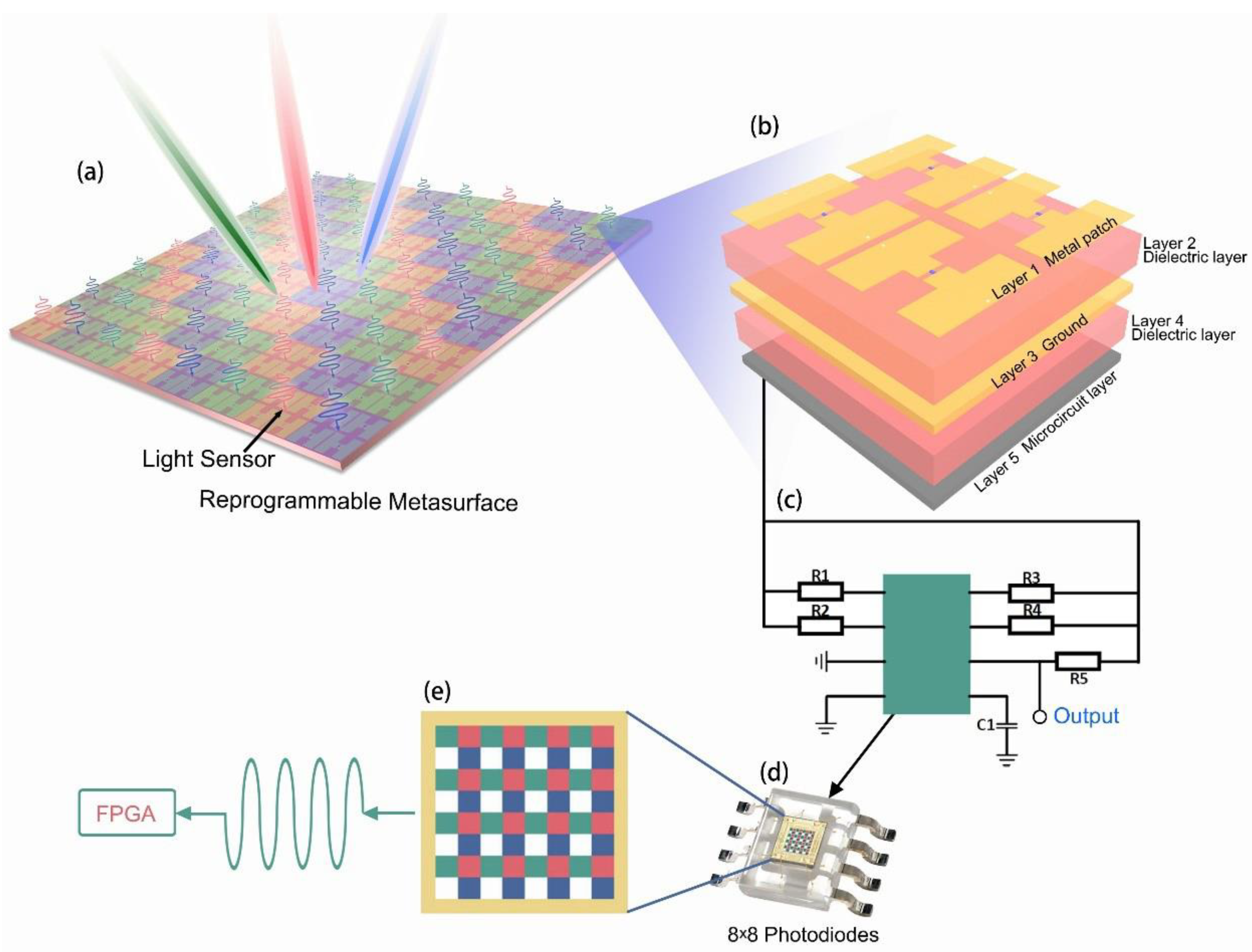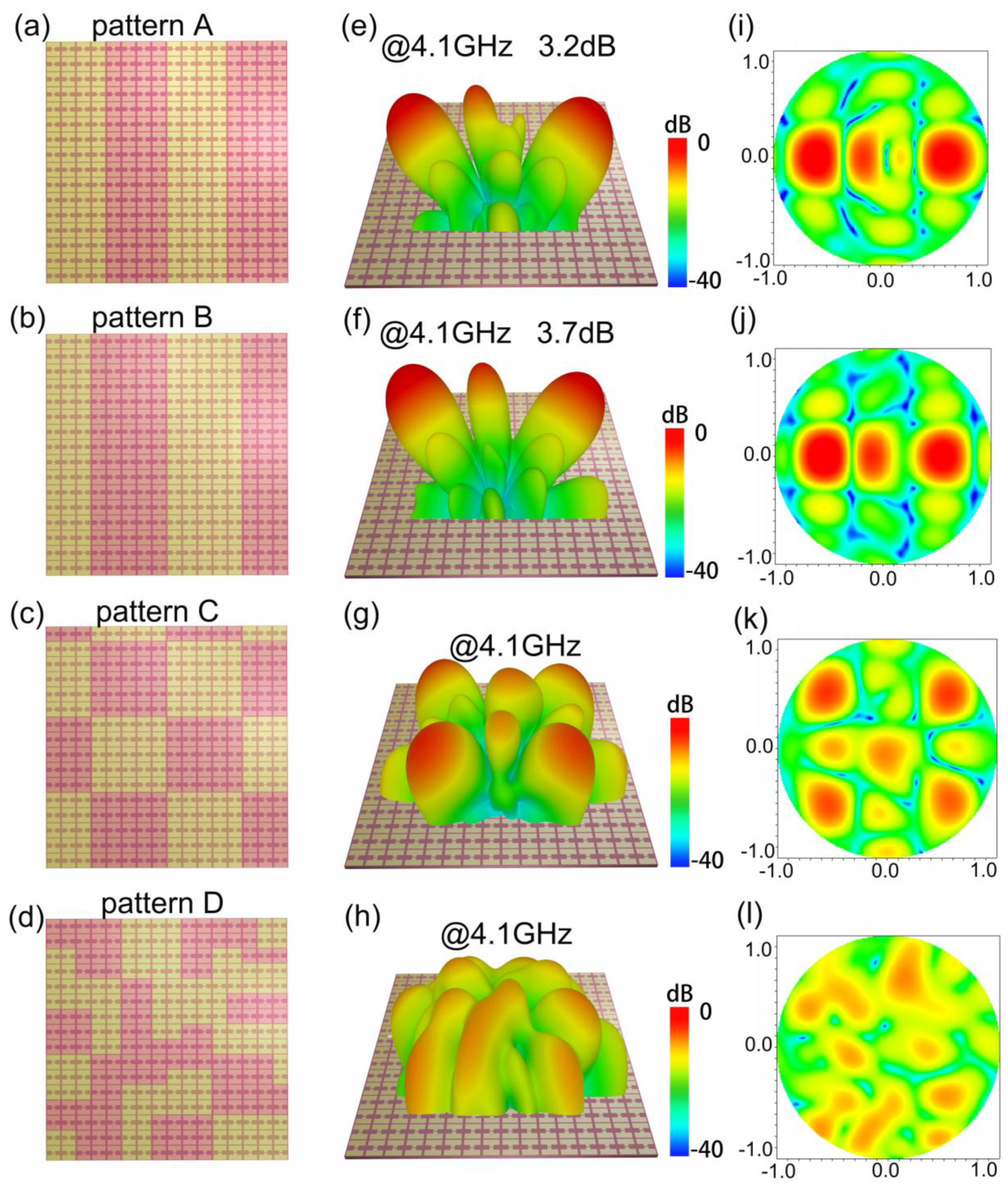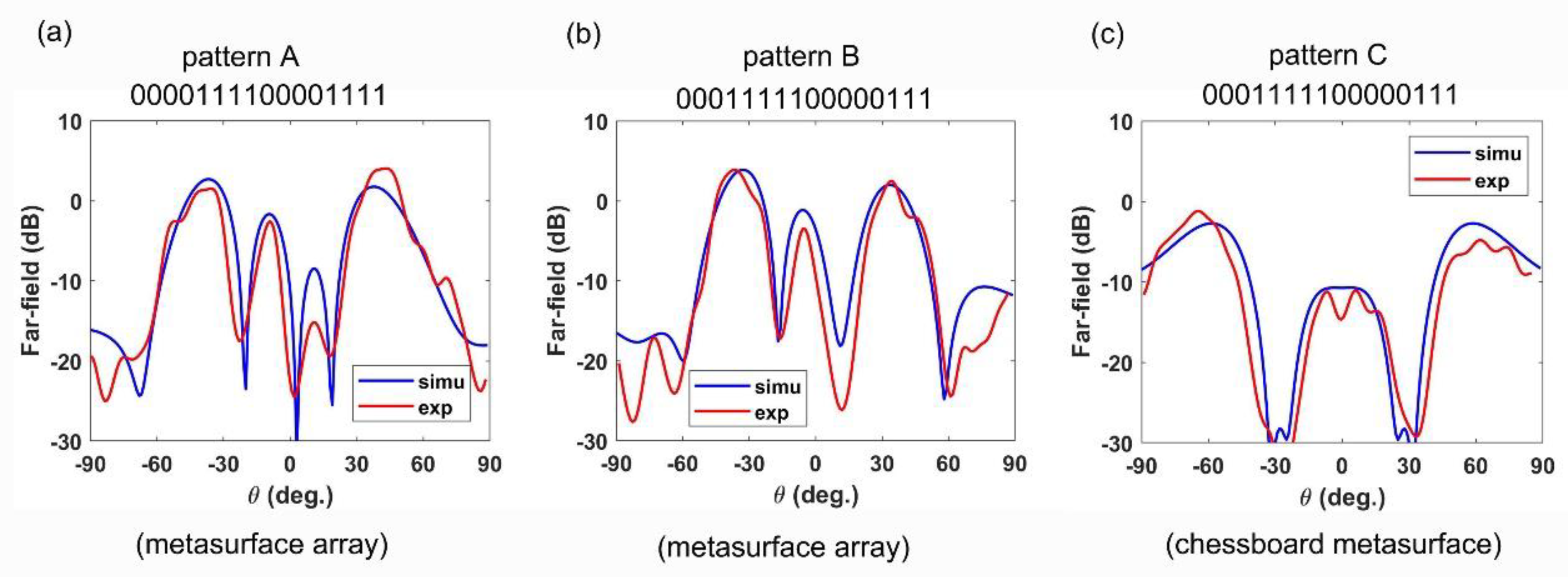Digital Programmable Metasurface with Element-Independent Visible-Light Sensing
Abstract
:1. Introduction
2. Principle and Design
3. Results
4. Conclusions
Author Contributions
Funding
Data Availability Statement
Conflicts of Interest
References
- El Dhaba, A.R. Reduced micromorphic model in orthogonal curvilinear coordinates and its application to a metamaterial hemisphere. Sci. Rep. 2020, 10, 2846. [Google Scholar] [CrossRef] [PubMed] [Green Version]
- Grbic, A.; Eleftheriades, G.V. Experimental verification of backward-wave radiation from a negative refractive index metamaterial. J. Appl. Phys. 2002, 92, 5930–5935. [Google Scholar] [CrossRef] [Green Version]
- Pendry, J.B.; Schurig, D.; Smith, D.R. Controlling electromagnetic fields. Science 2006, 312, 1780–1782. [Google Scholar] [CrossRef] [Green Version]
- Hao, J.; Yuan, Y.; Ran, L.; Jiang, T.; Kong, J.A.; Chan, C.T.; Zhou, L. Manipulating electromagnetic wave polarizations by anisotropic metamaterials. Phys. Rev. Lett. 2007, 99, 063908. [Google Scholar] [CrossRef] [PubMed] [Green Version]
- Xiao, Q.; Ma, Q.; Yan, T.; Wu, L.W.; Liu, C.; Wang, Z.X.; Wan, X.; Cheng, Q.; Cui, T.J. Orbital-Angular-Momentum-Encrypted Holography Based on Coding Information Metasurface. Adv. Opt. Mater. 2021, 9, 2002155. [Google Scholar] [CrossRef]
- Fang, N.; Lee, H.; Sun, C.; Zhang, X. Sub-diffraction-limited optical imaging with a silver superlens. Science 2005, 308, 534–537. [Google Scholar] [CrossRef] [Green Version]
- Ma, Q.; Mei, Z.L.; Zhu, S.K.; Jin, T.Y.; Cui, T.J. Experiments on Active Cloaking and Illusion for Laplace Equation. Phys. Rev. Lett. 2013, 111, 173901. [Google Scholar] [CrossRef] [PubMed]
- Shelby, R.A.; Smith, D.R.; Schultz, S. Experimental verification of a negative index of refraction. Science 2001, 292, 77–79. [Google Scholar] [CrossRef] [Green Version]
- Falcone, F.; Lopetegi, T.; Laso, M.A.G.; Baena, J.D.; Bonache, J.; Beruete, M.; Marques, R.; Martin, F.; Sorolla, M. Babinet principle applied to the design of metasurfaces and metamaterials. Phys. Rev. Lett. 2004, 93, 197401. [Google Scholar] [CrossRef] [Green Version]
- Alu, A. Mantle cloak: Invisibility induced by a surface. Phys. Rev. B 2009, 80, 245115. [Google Scholar] [CrossRef]
- Wu, H.; Bai, G.D.; Liu, S.; Li, L.; Wan, X.; Cheng, Q.; Cui, T.J. Information theory of metasurfaces. Natl. Sci. Rev. 2020, 7, 561–571. [Google Scholar] [CrossRef] [PubMed]
- Liu, S.; Cui, T.J.; Xu, Q.; Bao, D.; Du, L.; Wan, X.; Tang, W.X.; Ouyang, C.; Zhou, X.Y.; Yuan, H.; et al. Anisotropic coding metamaterials and their powerful manipulation of differently polarized terahertz waves. Light Sci. Appl. 2016, 5, e16076. [Google Scholar] [CrossRef] [PubMed] [Green Version]
- Chen, L.; Ma, Q.; Luo, S.S.; Ye, F.J.; Cui, H.Y.; Cui, T.J. Touch-Programmable Metasurface for Various Electromagnetic Manipulations and Encryptions. Small 2022, 18, 2203871. [Google Scholar] [CrossRef] [PubMed]
- Ma, Q.; Hong, Q.R.; Gao, X.; Xiao, Q.; Chen, L.; Cui, T.J. Highly integrated programmable metasurface for multifunctions in reflections and transmissions. APL Mater. 2022, 10, 061113. [Google Scholar] [CrossRef]
- Bao, L.; Ma, Q.; Bai, G.D.; Jing, H.B.; Wu, R.Y.; Fu, X.J.; Yang, C.; Wu, J.W.; Cui, T.J. Design of digital coding metasurfaces with independent controls of phase and amplitude responses. Appl. Phys. Lett. 2018, 113, 063502. [Google Scholar] [CrossRef]
- Yang, Y.; Jing, L.; Zheng, B.; Hao, R.; Yin, W.; Li, E.; Soukoulis, C.M.; Chen, H. Full-Polarization 3D Metasurface Cloak with Preserved Amplitude and Phase. Adv. Mater. 2016, 28, 6866–6871. [Google Scholar] [CrossRef] [PubMed]
- Ma, Q.; Chen, L.; Jing, H.B.; Hong, Q.R.; Cui, H.Y.; Liu, Y.; Li, L.L.; Cui, T.J. Controllable and Programmable Nonreciprocity Based on Detachable Digital Coding Metasurface. Adv. Opt. Mater. 2019, 7, 1901285. [Google Scholar] [CrossRef]
- Ma, Q.; Shi, C.B.; Bai, G.D.; Chen, T.Y.; Noor, A.; Cui, T.J. Beam-Editing Coding Metasurfaces Based on Polarization Bit and Orbital-Angular-Momentum-Mode Bit. Adv. Opt. Mater. 2017, 5, 1700548. [Google Scholar] [CrossRef]
- Cui, T.J.; Qi, M.Q.; Wan, X.; Zhao, J.; Cheng, Q. Coding metamaterials, digital metamaterials and programmable metamaterials. Light Sci. Appl. 2014, 3, e218. [Google Scholar] [CrossRef] [Green Version]
- Ma, Q.; Xiao, Q.; Hong, Q.R.; Gao, X.; Galdi, V.; Cui, T.J. Digital Coding Metasurfaces: From Theory to Applications. IEEE Antennas Propag. Mag. 2022, 64, 96–109. [Google Scholar] [CrossRef]
- Ma, Q.; Liu, C.; Xiao, Q.; Gu, Z.; Gao, X.X.; Li, L.; Cui, T.J. Information metasurfaces and intelligent metasurfaces. Photonics Insights 2022, 1, R01. [Google Scholar] [CrossRef]
- Ma, Q.; Cui, T.J. Information Metamaterials: Bridging the physical world and digital world. PhotoniX 2020, 1, 1. [Google Scholar] [CrossRef] [Green Version]
- You, J.W.; Ma, Q.; Lan, Z.; Xiao, Q.; Panoiu, N.C.; Cui, T.J. Reprogrammable plasmonic topological insulators with ultrafast control. Nat. Commun. 2021, 12, 5468. [Google Scholar] [CrossRef] [PubMed]
- Hong, Q.R.; Ma, Q.; Gao, X.X.; Liu, C.; Xiao, Q.; Iqbal, S.; Cui, T.J. Programmable Amplitude-Coding Metasurface with Multifrequency Modulations. Adv. Intell. Syst. 2021, 3, 2000260. [Google Scholar] [CrossRef]
- Luo, J.; Ma, Q.; Jing, H.; Bai, G.; Wu, R.; Bao, L.; Cui, T. 2-bit amplitude-modulated coding metasurfaces based on indium tin oxide films. J. Appl. Phys. 2019, 126, 113102. [Google Scholar] [CrossRef]
- Chen, K.; Feng, Y.; Yang, Z.; Cui, L.; Zhao, J.; Zhu, B.; Jiang, T. Geometric phase coded metasurface: From polarization dependent directive electromagnetic wave scattering to diffusion-like scattering. Sci. Rep. 2016, 6, 35968. [Google Scholar] [CrossRef] [Green Version]
- Wu, R.Y.; Zhang, L.; Bao, L.; Wu, L.W.; Ma, Q.; Bai, G.D.; Wu, H.T.; Cui, T.J. Digital Metasurface with Phase Code and Reflection-Transmission Amplitude Code for Flexible Full-Space Electromagnetic Manipulations. Adv. Opt. Mater. 2019, 7, 1801429. [Google Scholar] [CrossRef]
- Chen, L.; Ma, Q.; Nie, Q.F.; Hong, Q.R.; Cui, H.Y.; Ruan, Y.; Cui, T.J. Dual-polarization programmable metasurface modulator for near-field information encoding and transmission. Photonics Res. 2021, 9, 116. [Google Scholar] [CrossRef]
- Ma, Q.; Hong, Q.R.; Bai, G.D.; Jing, H.B.; Wu, R.Y.; Bao, L.; Cheng, Q.; Cui, T.J. Editing Arbitrarily Linear Polarizations Using Programmable Metasurface. Phys. Rev. Appl. 2020, 13, 021003. [Google Scholar] [CrossRef]
- Ding, G.; Chen, K.; Luo, X.; Zhao, J.; Jiang, T.; Feng, Y. Dual-Helicity Decoupled Coding Metasurface for Independent Spin-to-Orbital Angular Momentum Conversion. Phys. Rev. Appl. 2019, 11, 044043. [Google Scholar] [CrossRef]
- Ma, Q.; Hong, Q.R.; Gao, X.X.; Jing, H.B.; Liu, C.; Bai, G.D.; Cheng, Q.; Cui, T.J. Smart sensing metasurface with self-defined functions in dual polarizations. Nanophotonics 2020, 9, 3271–3278. [Google Scholar] [CrossRef]
- Chen, L.; Nie, Q.F.; Ruan, Y.; Luo, S.S.; Ye, F.J.; Cui, H.Y. Light-controllable metasurface for microwave wavefront manipulation. Opt Express 2020, 28, 18742–18749. [Google Scholar] [CrossRef] [PubMed]
- Chen, L.; Nie, Q.F.; Ruan, Y.; Cui, H.Y. Thermal sensing metasurface with programmable wave-front manipulation. J. Appl. Phys. 2020, 128, 075105. [Google Scholar] [CrossRef]
- Ma, Q.; Gao, W.; Xiao, Q.; Ding, L.; Gao, T.; Zhou, Y.; Gao, X.; Yan, T.; Liu, C.; Gu, Z.; et al. Directly wireless communication of human minds via non-invasive brain-computer-metasurface platform. eLight 2022, 2, 11. [Google Scholar] [CrossRef]
- Liu, C.; Ma, Q.; Luo, Z.J.; Hong, Q.R.; Xiao, Q.; Zhang, H.C.; Miao, L.; Yu, W.M.; Cheng, Q.; Li, L.; et al. A programmable diffractive deep neural network based on a digital-coding metasurface array. Nat. Electron. 2022, 5, 113–122. [Google Scholar] [CrossRef]
- Gu, Z.; Ma, Q.; Liu, C.; Xiao, Q.; Gao, X.; Yan, T.; Miao, L.; Li, L.; Cui, T.J. High-Resolution Programmable Metasurface Imager Based on Multilayer Perceptron Network. Adv. Opt. Mater. 2022, 10, 2200619. [Google Scholar] [CrossRef]
- Ma, Q.; Bai, G.D.; Jing, H.B.; Yang, C.; Li, L.; Cui, T.J. Smart metasurface with self-adaptively reprogrammable functions. Light Sci. Appl. 2019, 8, 98. [Google Scholar] [CrossRef] [Green Version]
- Goi, E.; Zhang, Q.; Chen, X.; Luan, H.; Gu, M. Perspective on photonic memristive neuromorphic computing. PhotoniX 2020, 1, 3. [Google Scholar] [CrossRef] [Green Version]
- Nguyen Thanh, T.; Tanaka, T. Characterizations of an infrared polarization-insensitive metamaterial perfect absorber and its potential in sensing applications. Photonics Nanostruct. Fundam. Appl. 2018, 28, 100–105. [Google Scholar] [CrossRef]
- Chen, L.; Ye, F.J.; Cuo, M.; Luo, S.S.; Hao, J.J.; Ruan, Y.; Cui, H.Y. Ultraviolet-sensing metasurface for programmable electromagnetic scattering field manipulation by combining light control with a microwave field. Opt Express 2022, 30, 19221. [Google Scholar] [CrossRef]
- Zhan, T.; Xiong, J.; Zou, J.; Wu, S.-T. Multifocal displays: Review and prospect. PhotoniX 2020, 1, 10. [Google Scholar] [CrossRef] [Green Version]
- Leonhardt, U. Optical conformal mapping. Science 2006, 312, 1777–1780. [Google Scholar] [CrossRef] [PubMed]
- Yu, N.F.; Genevet, P.; Kats, M.A.; Aieta, F.; Tetienne, J.P.; Capasso, F.; Gaburro, Z. Light Propagation with Phase Discontinuities: Generalized Laws of Reflection and Refraction. Science 2011, 334, 333–337. [Google Scholar] [CrossRef] [PubMed] [Green Version]
- Della Giovampaola, C.; Engheta, N. Digital metamaterials. Nat. Mater. 2014, 13, 1115. [Google Scholar] [CrossRef] [PubMed] [Green Version]
- Liu, S.; Noor, A.; Du, L.L.; Zhang, L.; Xu, Q.; Luan, K.; Wang, T.Q.; Tian, Z.; Tang, W.X.; Han, J.G.; et al. Anomalous Refraction and Nondiffractive Bessel-Beam Generation of Terahertz Waves through Transmission-Type Coding Metasurfaces. Acs Photonics 2016, 3, 1968–1977. [Google Scholar] [CrossRef]
- Li, L.; Cui, T.J.; Ji, W.; Liu, S.; Ding, J.; Wan, X.; Li, Y.B.; Jiang, M.; Qiu, C.-W.; Zhang, S. Electromagnetic reprogrammable coding-metasurface holograms. Nat. Commun. 2017, 8, 197. [Google Scholar] [CrossRef] [Green Version]
- Yang, H.; Cao, X.; Yang, F.; Gao, J.; Xu, S.; Li, M.; Chen, X.; Zhao, Y.; Zheng, Y.; Li, S. A programmable metasurface with dynamic polarization, scattering and focusing control. Sci. Rep. 2016, 6, 35692. [Google Scholar] [CrossRef] [Green Version]
- Liu, S.; Cui, T.J.; Zhang, L.; Xu, Q.; Wang, Q.; Wan, X.; Gu, J.Q.; Tang, W.X.; Qi, M.Q.; Han, J.G.; et al. Convolution Operations on Coding Metasurface to Reach Flexible and Continuous Controls of Terahertz. Adv. Sci. 2016, 3, 1600156. [Google Scholar] [CrossRef]






Disclaimer/Publisher’s Note: The statements, opinions and data contained in all publications are solely those of the individual author(s) and contributor(s) and not of MDPI and/or the editor(s). MDPI and/or the editor(s) disclaim responsibility for any injury to people or property resulting from any ideas, methods, instructions or products referred to in the content. |
© 2023 by the authors. Licensee MDPI, Basel, Switzerland. This article is an open access article distributed under the terms and conditions of the Creative Commons Attribution (CC BY) license (https://creativecommons.org/licenses/by/4.0/).
Share and Cite
Jiang, X.; Ye, F.; Tan, H.; Luo, S.; Cui, H.; Chen, L. Digital Programmable Metasurface with Element-Independent Visible-Light Sensing. Electronics 2023, 12, 241. https://doi.org/10.3390/electronics12010241
Jiang X, Ye F, Tan H, Luo S, Cui H, Chen L. Digital Programmable Metasurface with Element-Independent Visible-Light Sensing. Electronics. 2023; 12(1):241. https://doi.org/10.3390/electronics12010241
Chicago/Turabian StyleJiang, Xuqian, Fuju Ye, Hongrui Tan, Sisi Luo, Haoyang Cui, and Lei Chen. 2023. "Digital Programmable Metasurface with Element-Independent Visible-Light Sensing" Electronics 12, no. 1: 241. https://doi.org/10.3390/electronics12010241





